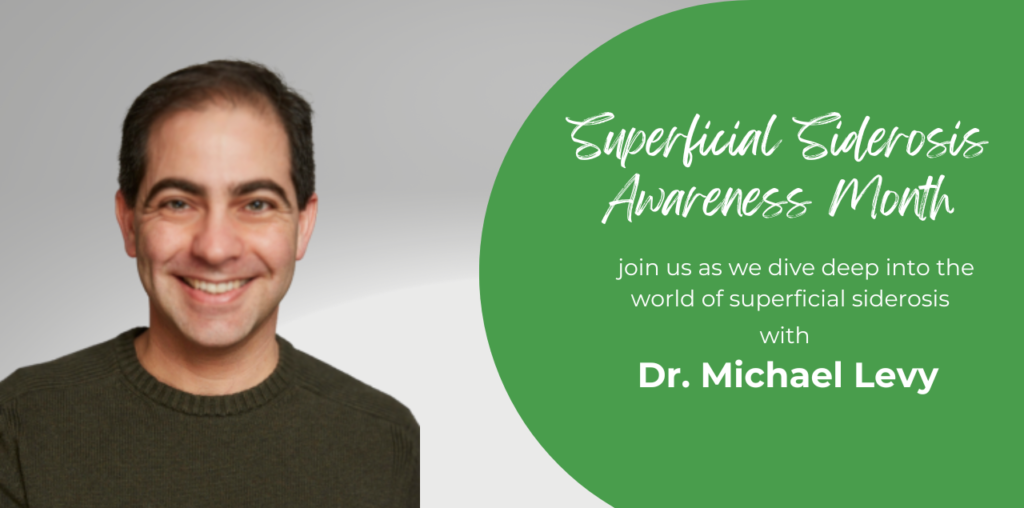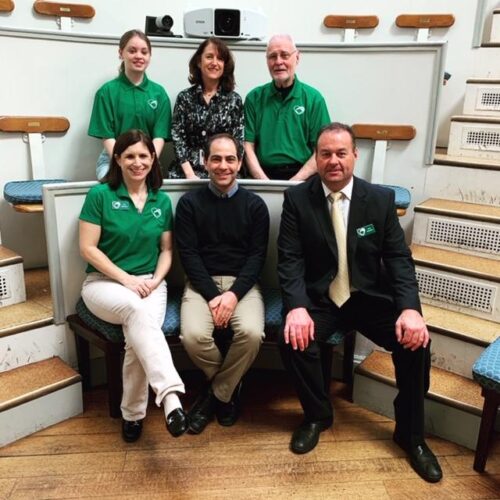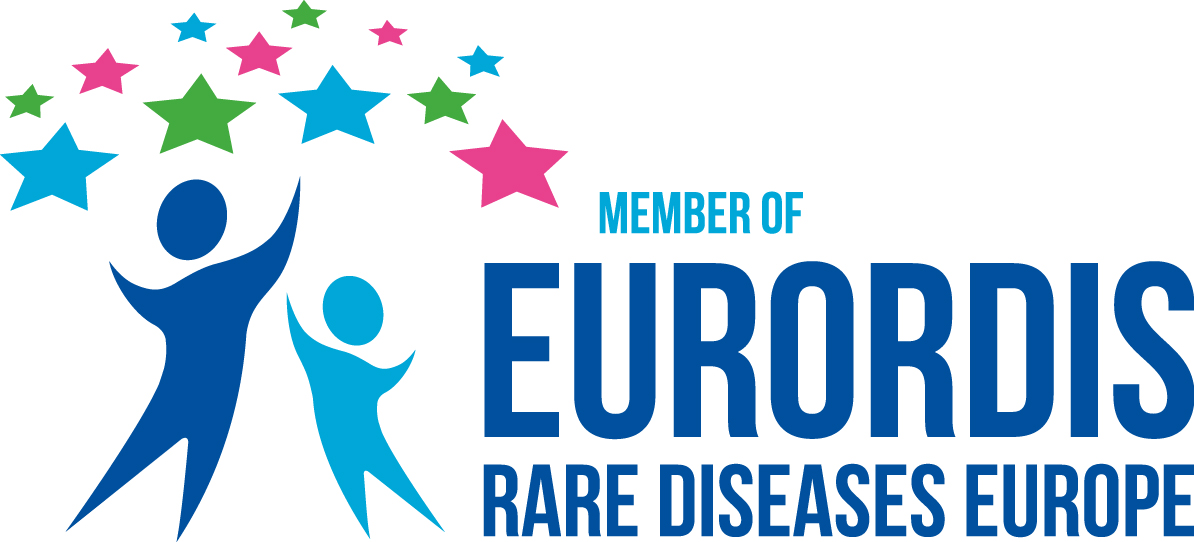
Power of Community: Celebrating Superficial Siderosis Awareness Month with Dr. Michael Levy
September is Superficial Siderosis Awareness Month
In keeping with this year’s Superficial Siderosis Awareness Month theme, “Power of Community: Our connection is our strength,” join us as we dive deep into the world of superficial siderosis through an enlightening conversation with Michael Levy, MD, Ph.D. As many in our community know, while Dr. Levy is the Chief Medical and Research Advisor to the Superficial Siderosis Research Alliance (SSRA), his heart lies with providing the best care possible to his patients at the Superficial Siderosis Clinic, Massachusetts General Hospital. Yet, beyond the titles and accolades lies a man fiercely dedicated to understanding this rare disease, ensuring patient care is at the forefront, and championing the power of community – our very own #teamsuperficialsiderosis.

For those navigating the complexities of superficial siderosis, caregivers supporting loved ones, families seeking clarity, and every donor and supporter of the SSRA, this dialogue promises to enlighten, shedding light on the past, present, and future of superficial siderosis research. Follow along with Rori Daniel as she engages in a heart-to-heart with Dr. Levy, exploring his journey, insights, and future aspirations in superficial siderosis research.
Superficial Siderosis: A Deep Dive with Dr. Michael Levy
Rori Daniel (RD): Dr. Levy, can you share with us how you first became interested in Superficial Siderosis (SS) research?
Dr. Michael Levy (ML): In 2005, when I was a neurology resident at Johns Hopkins Hospital, I was called to consult on my first case of superficial siderosis. I had never heard of the disease before and spent a great deal of time learning about this one case. I scoured the available literature and decided to review every case from the previous 100 years published in 20 languages. The review was published in 2006 – and my email address was listed as the corresponding author. From then on, patients and physicians would find my review and email me about individual cases. I tried my best to help, and over time I consulted and/or managed over 250 cases of superficial siderosis. In 2010, we conducted the first study of deferiprone, which showed promising results. In 2018, we published a longer 2-year observational study of deferiprone. We plan to launch additional studies with deferiprone and other iron chelators.
RD: Could you describe your educational and professional background that led you to collaborate with the SSRA?
ML: I attended medical school at Baylor College of Medicine in Houston, TX, where I grew up. I completed my medical internship, neurology residency, and neuroimmunology fellowship at the Johns Hopkins Hospital in Baltimore, MD. Johns Hopkins has expertise in a wide range of neurological diseases. I paired up with Rafael Llinas, a vascular neurologist, in my early studies on deferiprone and superficial siderosis. After that, I continued to develop my interest and expertise in superficial siderosis. I am honored to be part of the SSRA, supporting my research and advocating for people with superficial siderosis.
RD: What has been the most interesting or unexpected finding you’ve encountered when seeing patients in your clinic?
ML: I have seen patients with tremendous iron deposits on the surface of their brains and spinal cord and have little to no symptoms. I have also seen patients with very little iron on the brain suffer from extensive neurological damage. I have learned over time that the amount of iron is not the most important factor in the outcome of superficial siderosis but also the location of the iron, the amount of time the iron has been deposited, and the susceptibility of the tissue underneath the iron to oxidative damage.
RD: How do you feel about the current research agenda of the SSRA, and what do you believe are its most promising aspects?
ML: I support the current research agenda of the SSRA because it focuses on treatment. Many patients experience a declining, progressive course of disease, and we need to be able to stop the progression and stabilize neurological function.
RD: Can you discuss the challenges and rewards of working with a rare condition like superficial siderosis?
ML: The challenge of working in this field is that most doctors – and neurologists – have never heard of superficial siderosis. I have to explain things from a basic level to everyone I meet. On the other hand, I feel honored to be one of the leaders in the field to push research and clinical care forward for this ultra-rare disease.
RD: How has your collaboration with other researchers and clinicians contributed to advancing superficial siderosis research?
ML: I have met and collaborated with many researchers and clinicians over the years who have become interested in superficial siderosis as I have. Spreading awareness of this condition to other providers will improve clinical care for patients with superficial siderosis. Because the condition is so rare, we have to be able to collaborate across institutions and around the world to be able to recruit enough patients for studies.
RD: What are your thoughts on the future of superficial siderosis treatment? Are there any groundbreaking therapies or interventions on the horizon?
ML: I believe the problem in superficial siderosis is very straightforward: there is too much iron on the brain’s surface. Therefore, I am committed to finding new therapies that quickly, reliably, and safely remove that iron. We have been using deferiprone because it is the only iron chelator that can enter the brain. There are other iron chelators, but none remove iron from the brain. However, new iron chelators are being developed that may work even faster than deferiprone. There are also opportunities to mix and match medications to optimize outcomes.
RD: How do you approach the human aspect of superficial siderosis, particularly regarding patient care and support?

ML: I consider every patient a friend and member of my community. Especially because this condition is so rare and most doctors have not heard of it, I have dedicated extra time and effort to support patients in their journeys. This often means I am making phone calls to their doctors or insurance companies and sometimes advocating on their behalf to their employers. I feel like most patients would roll up their sleeves to contribute blood or time to my research, and I owe it to them to do everything I can to improve their lives.
RD: Can you share a memorable experience or success story from your work with patients?
ML: I have a handful of patients in whom iron chelation has been very successful. We have removed all or nearly all of the iron off the surface of their brains. I have been very impressed with their clinical response. It has reinforced the idea in my mind that if we could get this excess iron out of people’s brains, we can make a real impact on this disease.
RD: How do you feel about the SSRA as an organization, and what do you believe sets it apart in the field of rare disease research?

ML: SSRA is an amazing organization that has already raised more than $100,000 for my research, even though there are fewer than 500 people with this condition in the United States! They are dedicated to curing this disease and will do everything I can to help make that possible.
RD: What are your current research projects related to superficial siderosis, and how do they align with the broader goals of the SSRA?
ML: Our current research projects are related to identifying better and faster, and safer iron chelators that can work to remove iron from the brain of patients with superficial siderosis. Secondly, we need better MRI outcome measures to ensure that we are making progress with these medications. MRI can show us the extent of iron deposits, but quantification is very difficult. There are ways to do this, and we are working collaboratively with scientists and neurologists worldwide.
RD: How do you balance your roles as a clinician, researcher, and advisor, and what drives you in each of these capacities?
ML: First and foremost, I am a clinician. My top priority is to take care of patients with superficial siderosis. But to do this, I know I must discover better treatments. That involves research. And this research requires money, which is where SSRA has been instrumental. They have supported me from the start. I hope to continue this collaboration until all my patients are free from iron deposits.
RD: What advice would you give to young researchers and medical professionals interested in pursuing a career in rare disease research, specifically in superficial siderosis?
ML: I advise young researchers and medical professionals interested in pursuing a career in rare disease research that while it can be hard to secure funds for research, patients with rare diseases are very appreciative of our interest in their disease. It has been a very rewarding experience for me to care for these patients, and there is an ongoing need for new talent in this field.
RD: How do you envision the relationship between the SSRA, the medical community, and the patients evolving in the coming years?
ML: The SSRA is one of the only advocacy groups specifically for superficial siderosis. As more patients are diagnosed and new treatments are developed for this condition, the SSRA will continue its mission to advocate for the disease so that recognition is improved and treatments are administered to all patients who need them.
Reflecting on the Journey and Looking Forward
RD: Finally, as we observe Superficial Siderosis Month this September, what message would you like to convey to the SS community, including patients, caregivers, researchers, and the public?

As we observe Superficial Siderosis (SS) month, I want to extend a heartfelt message to the SS community, including patients, caregivers, researchers, and the public.
To the Superficial Siderosis community, this month provides an opportunity to come together, raise awareness, and offer support to one another. Superficial siderosis is a rare and progressive neurological condition caused by iron accumulation in the brain and spinal cord. It can profoundly impact the lives of those affected and their families.
To patients living with Superficial Siderosis, know that you are not alone in this journey. Reach out to support groups and connect with others who understand your challenges. Stay informed about the latest research and treatment options, and work closely with your healthcare team to manage your symptoms and maintain the best possible quality of life.
To caregivers, your dedication and compassion are invaluable to those battling Superficial Siderosis. Your support can make a significant difference in the lives of your loved ones. Remember to take care of yourself as well, as caregiving can be demanding.
For researchers, your commitment to studying Superficial Siderosis is vital. Through your efforts, we hope to gain a deeper understanding of the condition, develop improved diagnostic tools, and identify more effective treatments to slow its progression or alleviate symptoms.
To the public, raising awareness about Superficial Siderosis is essential. By understanding this condition, we can foster empathy and support for those living with it and encourage further research and resources to aid their journey.
Let us join hands in solidarity and compassion, promoting understanding and empathy within the Superficial Siderosis community and beyond. Together, we can positively impact the lives of those affected by this rare neurological disorder and strive for a brighter future.
– Dr. Michael levy

RD: As our conversation ends, I find myself filled with gratitude. Dr. Levy, your willingness to share such profound insights and thoughts with us is invaluable. When I say how grateful we are for your support, I speak for the superficial siderosis community. Your dedication and commitment to understanding and advancing the cause of SS is a beacon of hope for many. On behalf of all of us, a heartfelt thank you.
Join #teamsuperficialsiderosis
In the dynamic landscape of rare diseases, our journey with superficial siderosis is a testament to the power of community. Dr. Levy’s dedication, combined with the unwavering support of our superficial siderosis community, paints a promising picture of progress and hope. Together, as #teamsuperficialsiderosis, we move forward believing that “Our connection is our strength.” Let’s champion this spirit, not just Superficial Siderosis Awareness Month this September but every day.


